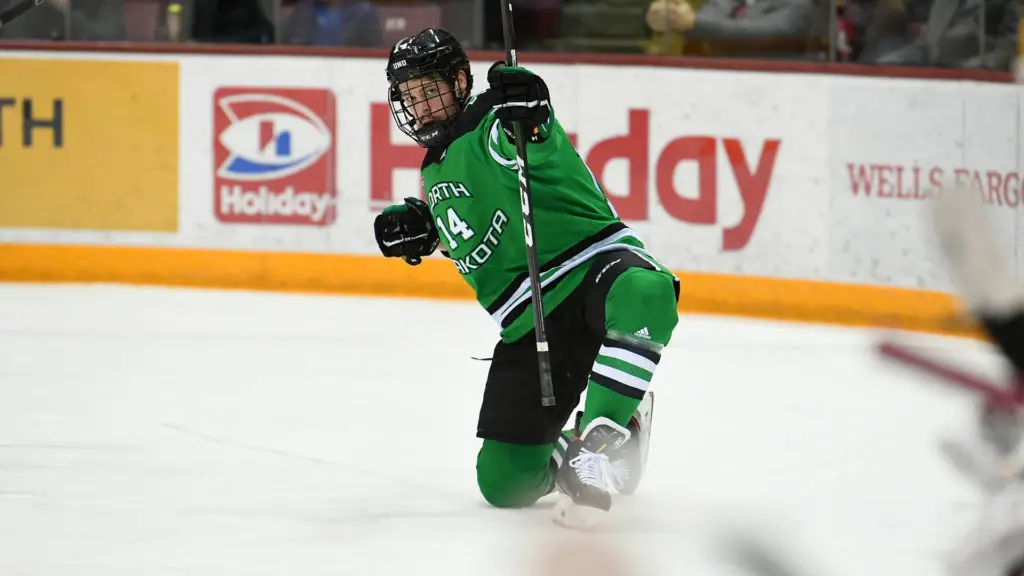
Each week during the season, we look at the big events and big games around Division I men’s college hockey in Tuesday Morning Quarterback.
Jim: First off, let me welcome back Dan Rubin who fills in this week for Paula Weston. Always good to have you alongside.
Dan, I’ll start at the top where we saw a good amount of success this weekend. No. 1 Boston College, No. 2 North Dakota, No. 3 Minnesota State and No. 5 Minnesota all posted two-game sweeps over the weekend, leaving a lot of stability at the top of the USCHO.com poll. In a typical season, we would be looking at the PairWise and likely called all four of these teams locks for the NCAA tournament.
Even in a crazy season like this where we’re about a month away from Selection Sunday and still don’t know what criteria the committee will use to select the field for this year’s NCAA tournament, I still feel like each and every week, I’m secure in calling each of these four teams NCAA locks.
Now, I understand that a lot can change over the next 30 days or so, but are we at a point that this quartet should feel safe about their NCAA tournament future?
Dan: Thanks for having me, Jimmy, for at least one more go around as the season draws closer to its end!
Indeed, all four of those teams issued some major statements with their weekend sweeps, but I’m going to hesitate to lock all four of them into the national tournament. I think BC and North Dakota are the two most logical teams in that equation, and Minnesota State is running through its annual WCHA exercise of winning every game. So I’m going to include the three of them as certified locks for the NCAA Tournament.
Shockingly, the one team I’m going to leave out of that for now is Minnesota, which is an inexplicable thing I can’t believe I’m saying.
The Gophers were once locks for the No. 1 overall seed back in January when they swept Arizona State to improve to 10-0, but this past weekend’s wins over Notre Dame only pushed them to 7-5 in the weeks since. Those two losses to Wisconsin from a couple of weeks ago particularly hurt them in my mind, and their second half resume has been hot and cold over the last month. I think they’re as close to a lock as a non-lock can be, and I think it would take an unprecedented, monumental collapse over these next couple of weeks to keep them out. That 99.9 percent isn’t 100, though, in my mind, and that will always make me nervous for anyone this year, especially in the Big Ten, which is borderline the Wild West to me.
So this week, I’m keeping Minnesota out. Next week, I’m likely shuffling them in.
The grouping after the locks – those borderline locks – are the ones that I think are the most interesting bunch. Who are you seeing in that next group, the ones that are probably a week or two away from shoring up a trip to the tournament?
Jim: Well, why don’t I turn my attention to the defending national champion, Minnesota Duluth, a team that I think may be a ranked a little higher than necessary (though they did fall four spots to eighth this week). Part of me feels that inflated ranking is an historical bias.
Yes, they play in the NCHC, arguably one of the toughest conferences top to bottom. But the Bulldogs consistency – or lack thereof – concerns me. This same Minnesota Duluth team walloped Western Michigan a few weeks back, but this past week managed a single goal against the Broncos, getting outscored 8-1.
Consistency is what I’ve tried to look for in teams as a barometer this season. Looking through the conferences, that’s been a challenge. No team in the Big Ten has been overly consistent. The same can be said for the quartet in the ECAC, though Quinnipiac is beginning show consistency. Hockey East, Boston College and Massachusetts have been the most consistent, with a late-starting Boston University team looking like they can earn that moniker. Both Minnesota State in the WCHA and North Dakota in the NCHC earn a consistent rating. And in the league you see most, Atlantic Hockey, I guess only AIC (and maybe Robert Morris) have shown they can play well night in and night out.
But it leads me to ask, in a season where we are lacking any sort of measuring stick besides wins and losses, should consistency be something the NCAA committee looks at when selecting the field?
Dan: I would rather the committee look at second half performances over full-season consistency if resumes are identical or similar. I know the NCAA utilizes a criteria for soccer defined as “late season performance,” which is a team’s record in its last eight games, including conference tournaments, to weight a hotter team at the end of the year. That helps identify programs that are playing better and didn’t necessarily take advantage of another team’s slow start.
There are rightfully issues with that as a criteria because it, in a way, denigrates a team’s fast start or better play, but I think this year, teams that are playing better at the end of the year are the teams that are probably going to be better suited for the national tournament. In a weird year, I want teams to win their way into the bracket, as cheesy as that sounds.
I think there’s an imperfect science, but all of this is contingent on bracket busters not outright winning their conference tournaments. In Atlantic Hockey, AIC and Robert Morris are the clear favorites and might be able to get two teams from the league into the NCAA tournament for the first time in almost a decade, but some teams that hiccupped, either due to a start or restart on their seasons, could really throw a wrench into all of that.
I look at a team like Army West Point as a potential disruptor to the dance party because the Black Knights are one of the nation’s hottest teams right now. In a league like Atlantic Hockey, there’s also the possibility that Bentley or Sacred Heart, preseason favorites in their own right, go on runs in the postseason.
At that point, does the committee still debate on a team like AIC, which is currently ranked high enough in every metric to warrant discussion? It’s something I know I’ve talked about at length as the postseason dawns.
The biggest thing that will ultimately impact everything is, to me, the single elimination conference tournaments because a team can really torpedo its chances with a bad game. Every league with the exceptions of Atlantic Hockey and the WCHA announced transitions into a single-loss format this year with most moving to single-site championships. Those two remaining leagues still haven’t formally announced changes, but I can’t see a way that traditional formats remain in place. So as we get closer to championship weekends, someone is going to throw everything into a loop.
Chaos, thy name is college hockey.
Switching gears a bit, you and I both attended the call this week for the College Hockey for Diversity, Equity & Inclusion initiative, and I can readily admit that the folks on that call moved me with their honest, raw emotions and opinions. It’s forced me to soul search myself a bit, which is commonplace these days, and see what I can do to help advance this endeavor. I’m curious about your overall thoughts about their mission and some of the biggest takeaways you had from hearing everyone speak.
Jim: I’m glad you brought that up.
To me, what has been established in this initiative is a good start, but only that. This is an initiative that has a starting line but it is very hard to determine if there is a finish line. That’s what always stands out to me with grassroot social movements. We, as a college hockey community, can’t applaud efforts of the College Hockey for Diversity, Equity & Inclusion initiative on the night it was announced and then act like it never happened. That is my main fear.
Listening to the student athletes, two of the topics that seemed critical and, having been around the game for more than two decades I agree are massive problems are racism and locker room culture. These aren’t totally separate issues as racism players have felt – and we heard stories told first-hand last week during the press conference that launched the initiative – often begins in the locker room.
I think that is a major cultural change that college hockey, among many other sports, needs. I will admit, I don’t have a solution. But I do believe that it is incumbent upon every single person involved in the game to be more aware of how we treat people, particularly when the world isn’t watching. If you wouldn’t say something on national TV, why might it be okay to make a similar statement behind closed doors and then simply classify it as “locker room talk.”
I applaud all of those involved in this initiative, and hope that in days, weeks, months and years to come that these people and all involved in college hockey, can make positive change.
Dan: I believe hockey at its best is the greatest sport on the planet because it stresses selflessness and determination. It teaches toughness through teamwork under this umbrella of sacrifice, and the team is always bigger than the player. Those stories of players gutting through broken bones or receiving stitches on the bench are legendary, and it creates a completely unique bond between both teammates and adversaries. It’s why we shake hands after playoff series; we’re going to batter each other and do everything it takes, but we’re going to focus on respecting one another after it’s done.
I also recognize how hockey at its worst twists that very notion into the culture you mention and we heard about. Like you, I agree that the massive issues surrounding the sport center on the culture fostering an image of unacceptable speech in locker rooms, and I know I soul-searched after that call to analyze my behavior and what I could do to help them push this initiative forward. I believe this is an ugly fact about college hockey we all have to face, and my conversations after the call highlighted that things someone considers innocuous – a word, a phrase, a joke, the very way we talk to each other – might be supremely hurtful to someone else.
Also like you I admit that I don’t have a solution or an easy way through this, but I think that soul searching at least starts with all of us. Those bonds that I mention as the best part of the sport should drive us to want to constantly do more for our teammates so they don’t feel prejudiced against due to race, religion, sexual orientation, gender or anything else that would make this sport less inclusive.
I will say this – I am supremely proud of how those college kids stood up and told their stories, and I’m equally as proud of the conferences, coaches and administrators for their personal experiences and representations. I’m sure those conversations weren’t easy to have, but maybe we can all make a difference somehow. I’m not sure what it will look like in five or 10 years, but I hope this is the first step on a massively successful journey for positive change.


